Learn how to easily measure marketing campaign effectiveness!
Special-edition eBook - How to plan, execute, measure, and analyze your digital marketing campaigns.
My guide will walk you through developing your marketing strategy. Then, I’ll explain the five steps to creating your marketing plan, plus what you should include. You’ll find practical and actionable steps, working templates, and real-life examples.
Table of contents
- What is a marketing strategy?
- Marketing strategy vs marketing plan
- Why do I need a marketing strategy?
- Developing your marketing strategy
- Presenting your marketing strategy
- Marketing strategy to marketing plan in 5 steps
- Your marketing plan
What is a marketing strategy?
Let me point out that if you get to the end of this guide, draw up a cracking marketing strategy, then put it in a drawer and forget about it… you’ll be doing yourself no favors.
You have to refer to it regularly. Every time you plan a campaign. Every time you launch a new product. Every time you work with an influencer. Every time you plan an event.
Every time.
It’s your long term game plan that’ll show you...
- How you’re going to reach and engage consumers
- How you plan to convert consumers into customers
- How to write your marketing plan
A comprehensive marketing strategy will include...
- Your value proposition
- Your competitive advantage in the market
- The demographics of your target audience
- Key marketing messages
- Your tone of voice
- And more
Your marketing strategy is a constant from where you create your marketing plans. Now and in the future.
Your target audience will be made up of what you consider your ideal customer. If you haven't done this exercise, you'll need to download my free buyer persona template. Based on real data, it'll define your audience's behavior, pain points, goals, etc. Teaching you how to speak their language and deliver the goods.
Marketing strategy => marketing plan => execution => win!
Look up strategy in a thesaurus and one of the synonyms up for offer is - plan.
But, that’s not quite right when we’re talking about marketing
Marketing strategy vs marketing plan
Marketing strategy | What | Thinking
The big picture, shaped by your business strategy, your marketing strategy is your purpose. Your USPs, brand messaging. It’s what you’re offering and how you’ll deliver it with your marketing efforts. Having a clearly defined marketing strategy is essential if you want your business to grow. Once your strategy is determined, you’ll be equipped to develop an effective marketing plan.
Marketing plan | How | Doing
How you’re going to deliver your key messages. What you’re going to do. On which platforms. The timeline. How you’ll measure and analyze success. Your marketing plan is how you intend to reach your marketing goals. A roadmap that will direct you through each step. From where you build your marketing campaigns.
Example...
- Objective = to expand your business outside of Europe to an international market
- Strategy = engage and target a global audience
- Plan = create a personalized marketing campaign that reaches out and engages with specific segments - language, consumer behavior, buying habits
Why do I need a marketing strategy?
Simples.
It’s a roadmap for you, your team, and your business to follow. It’ll help you...
- Measure and analyze results against your goals
- Target consumers relevant to your products
- Prove the impact your marketing campaigns have on your brand reputation
Your long-term marketing strategy will build a sustainable competitive advantage. It’s all your marketing goals in one place. You’ll have done extensive market research. You’ll be focusing on the best product mix so you can achieve maximum profit and grow your business. Your marketing strategy is the foundation of all your future marketing plans.
Important stuff.
Your marketing strategy...
- Explains your objectives and how you’re going to execute them
- Formalizes ideas and concepts
- Identifies your target audience - purchasing power, behavior, demographics
- Defines how you’re going to market your products and services
- Helps you get financial backing
- Keeps your marketing focused
A successful marketing strategy will...
- Win new customers
- Increase sales and revenue
- Encourage your existing customers to spend more
- Support the launch of new products and services
- Better establish your brand on the market and increase market share
- Confirm your tone of voice and brand identity
- Reduce churn and strengthen customer loyalty
- Support the launch of advertising, PR, PPC campaigns
- Guarantee your business stays focused and current
- Make you an industry leader
To build an effective marketing strategy that’ll support future marketing plans, you need discipline, time, and focus.
The process is challenging, make no mistake. But, you don’t have to start with a blank sheet, this post - Marketing strategy to marketing plan - will steer you to success.
Also, download your free copy of my special-edition eBook: Digital Marketing Strategy Guide. You'll learn how to maximize the impact of your brand and increase your productivity. It's packed full of free templates, tips and tricks, simulated Talkwalker reports, and checklists. All you need, in one place.

Developing your marketing strategy
Establish a clear path of action.
Your strategy, if a comprehensive one, will be around for a while. At the same time, you have to remain open to changes and improvements if for instance, your competitors take a new direction, you take a new direction. Flexibility is the name of the game.
Let’s take a look at how to start writing your marketing strategy:
Executive summary
- An outline of your marketing strategy
Business analysis
- Business goals
- Marketing goals
- Challenges
- Objectives and how you’ll reach them
- Strengths and weaknesses of team, business, products, services - perform a SWOT analysis of your business
Market analysis
- Market size
- Market segments
- Growth expectations
- Customers’ behavior and spending power
- Impacts that could affect your market - trends, economy, etc.
Competitor analysis
- Monitor their messaging, marketing tactics, social media channels, products
- Compare pricing, customer support, sales funnel, marketing channels, customer demographics, messaging, etc.
- Market share comparison
- Share of voice - SOV - in your industry
- Their strengths and weaknesses compared to yours - perform a SWOT analysis
Target audience
- Segment your existing customers and target consumers - buyer persona - according to their characteristics - what they want from your brand- high quality products, low cost, 24/7 customer support, location, etc., their demographics, pain points, goals, buying habits, etc.
- How your audience perceives your brand - user-generated content from happy and unhappy clients. Why are they happy/unhappy?
- Once you’ve segmented, compare your positioning with that of your competitors - customer support, cheaper/more expensive, fast to market, targeted countries, USPs, etc.
Service and/or product analysis
- The products/services you deliver to the market
- USP - what makes your product or service unique?
- Benefit for each market segment - price, location, etc.
- How you deliver your offerings
Promoting channels
- Website
- Blog posts
- Social media
- Email campaigns
- Promotions and offers
- PR
- Paid ads
- Events and trade shows
- Traditional press
- TV and radio
- Word of mouth
Having agreed your marketing strategy, you’re now ready to write your marketing plan. Your plan will identify budgeting, deadlines, key team members, channels, etc.
Remember what I said earlier, about having a flexible strategy? Your plan, more so. Suppliers increase their prices, consumer behavior changes, team members move on, economies change, markets shift. Be ready to update.
Presenting your marketing strategy
Ready to present your marketing strategy to the board?
Your strategy - your business model - will define your objectives and business goals. You’ll win new customers, boost sales, strengthen your brand value, and increase your ROI. Your marketing strategy will help focus your team’s efforts. It’ll be the foundation on which you build future marketing plans and campaigns. And, determine how you should spend your budget.
You must be honest, you must be brutal.
Look at your business and find your strengths and weaknesses, your value proposition, your competitive advantage, your target market. When your board asks, you need to be ready to answer these questions...
- Who’s our ideal customer?
- What value do we bring that benefits the market and differs from our competitors?
- How do you want consumers to see us, our personality as a brand?
- What’s the ideal customer experience? How will you achieve it?
- What’s our core message that explains who we are, what we offer?
- How will you make the market aware of our brand?
- What revenue sources do you suggest we use to expand our business?
- How will you nurture consumer trust in our brand?
- What partnerships will you be working towards to make your strategy work?
- What will be the end result if we follow your marketing strategy?
You’ll have to prove you’ve done your research. That you understand your target market, customers, competitors, budget, and costs.
Measuring performance is a given. KPIs should be determined so you can measure the marketing effectiveness of your content - tracking email subscribers, email engagement rate, site traffic, time spent on your website, etc.
Marketing strategy to marketing plan in 5 steps
Okay, marketing strategy agreed, time to work on your marketing plan.
Here are the five tried and tested steps that’ll help you create your next marketing plan.
- Step 1 Reporting on last year’s marketing plan
- Step 2 Generating ideas
- Step 3 Strategy
- Step 4 Setting your goals
- Step 5 Planning next year’s marketing plan
Step 1 Reporting on last year’s marketing plan
There are two reasons to report on last year’s plan:
#1 - You’ll be asked to demonstrate how you dealt with the priorities for the year, to show the big picture. What was the ROI? Were the results good or bad, targets met, goals achieved? Don’t get lost in details, you just need to show the bottom line.
#2 - If you don’t review your marketing plan and all your campaigns, how will you know whether they’re working? Should a campaign be dropped as a non-starter? Would a campaign improve if tweaked? Are people engaging with your messaging? If you can’t answer these questions, you won’t be able to plan future campaigns successfully.
Understand your current position
Why do you need goals?
If you don’t know where you want to end up, how will you know how to get there and whether you’ve arrived or not?
To set achievable marketing goals, you need to evaluate your current marketing plan. What’s working, what’s bombing?
Example
If blog traffic has increased by 10% for the last six months, a 15% month-over-month target is challenging, but not impossible.
Objectives vs results
What were your business goals? They could include...
- Boost sales
- Increase brand awareness
- Enter new markets
- Raise more revenue
- Reach new audiences
- Get funding
- Increase profits
Fine-tuning your marketing goals could be...
- Increasing newsletter subscribers
- Getting more traffic to your website
- Improved conversion rates
- Earn more followers on social media
- Email - increase open rate, click-through rate, bounce, unsubscribes
- Social media - growth of followers, engagement, post reach
- Paid search - click-through rate, average cost-per-click, conversion rate
- SEO - improve keyword ranking & page ranking, backlink acquisition, domain authority
What did you do? Did you launch a social media marketing campaign? Optimize/repurpose blog posts? Initiate a PPC or SEO strategy? Take a look at the more specific examples below:
Example 1
- Goal - to increase monthly traffic to website by 11%
- Result - an increase of 15% due to strong second quarter and success of campaign X
Example 2
- Goal - to get 30% more newsletter subscribers
- Result - 22% due to blog CTAs that were only fixed in Q4
Example 3
- Goal - to increase number of followers on Twitter by 10%
- Result - 12% increase due to competition run during Q3
Quantitative analytics vs qualitative analytics
What worked and what didn’t?
To answer this, use qualitative and quantitative analytics. I’m sure you know what they are, but just in case:
Quantitative analytics - looking at figures to get hard data on how consumers behave
Qualitative analytics - putting data into context to understand why consumers behave a certain way
What were the results of your previous marketing campaigns? Reporting on your campaigns effectively isn’t always easy, but it’s vital that you have a high-level overview. You can then summarize what worked and what didn’t.
This free campaign management cheat sheet will help you report on your campaigns. It highlights best practices and the metrics to prove campaign performance.
Download my Free Campaign Management Cheat Sheet!
SWOT analysis
SWOT is old school. But it works.
SWOT refers to strengths, weaknesses, opportunities, and threats. It’s a comprehensive audit that helps you identify the internal and external factors affecting your team’s future performance. What differentiates you from your competitors. Strengths and weaknesses are internal factors, opportunities and threats are external.
If performed with brutal honesty - no point otherwise - this analysis will be a vital part of your planning process in which financial and operational goals can be set for the upcoming year, and campaigns can be created to accomplish these goals.
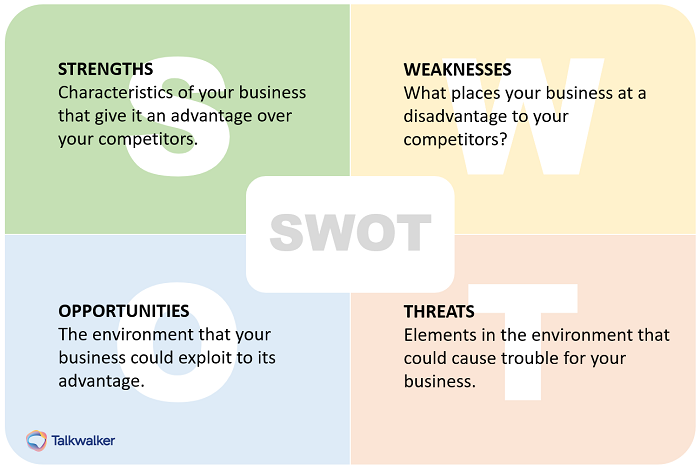
Old school marketing strategy - SWOT analysis.
For constructive SWOT analysis, you have to be brutally honest about the good and bad points of your business. Most of the information is subjective, so keep it simple.
What are your strengths?
- What makes your team awesome?
- What advantages can your team leverage?
- What quality or cost effective resources are available to you but not others?
- Which factors result in definite sales?
- What do your competitors consider your strengths?
- What are your USPs?
Example - your team, strong brand, loyal customers, healthy balance sheet, unique tech
What are your weaknesses?
- What internal processes need improvement?
- What do customers say needs improving?
- What technology limitations do you suffer?
- What factors contribute to loss of sales?
- What do competitors see as your weaknesses?
- What activities should you avoid?
Example - brand perception is weak, out of date technology, skills lacking, slow to publish
What are your opportunities?
- Are there market trends you should follow that you'd benefit from?
- What isn't your competition doing that you could - content, ads, markets?
- Are there any good opportunities on the horizon?
Example - cross-selling, entering new markets, offering new services, partnerships/co-branding, competitors late to jump on trends
What are your threats?
- What are your barriers?
- Has a technology change made your product obsolete or less favorable?
- Are your competitors working on a better product or service?
- Do you have cash-flow or debt issues?
Example - customer choice, new competitors entering your industry, new products launched, channel conflicts, economic downturn, competitors outranking you in search engines.
TOWS analysis
SWOT analysis finished, now it’s time for another acronym - TOWS.
TOWS analysis allows you how to exploit your strengths to maximize your opportunities and minimize threats. Or, create strategies to minimize weaknesses by taking advantage of opportunities and minimize weaknesses to avoid threats.
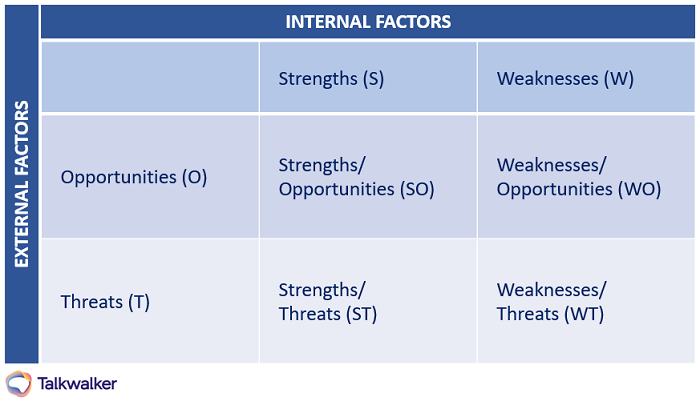
Marketing strategy - TOWS analysis - be honest or you're wasting your time.
When you start planning a process, you’ll perform a SWOT analysis. A TOWS analysis helps you work out how to move forward.
There are four TOWS strategies...
- Strengths/Opportunities (SO) - strengths exploiting opportunities
- Weaknesses/Opportunities (WO) - overcome weaknesses, exploit opportunities
- Strengths/Threats (ST) - exploit strengths to overcome potential threats
- Weaknesses/Threats (WT) - minimize weaknesses to avoid possible threats
Results of a TOWS analysis will depend on how honest you’ve been with your data. Just saying...
PEST analysis
PEST analysis - an element of crisis management - ensures a company is prepared for a change in external factors, such as political, economical, technological, social.
Is a change an opportunity to improve? Is it a threat? How will you manage this change?
Answer these kinds of questions about your business and about your competitors. The answers should be included in your marketing strategy. PEST analysis includes the following potential changes that could impact your business...
- Politics - governmental regulations that could affect the market - political stability, trade restrictions, tax laws, safety regulations, employment laws
- Economic - situations that'll impact your industry - interest rates, inflation, exchange rates, economic growth, unemployment rate, policy changes
- Social - the socio-economic environment of your industry - consumer demographics, culture and lifestyle attitudes, education, languages - understand consumer behavior and motivations
- Technological - tech impacting the launch of a new product - technological advancements, lifestyle of technology, money spend on R&D by governments
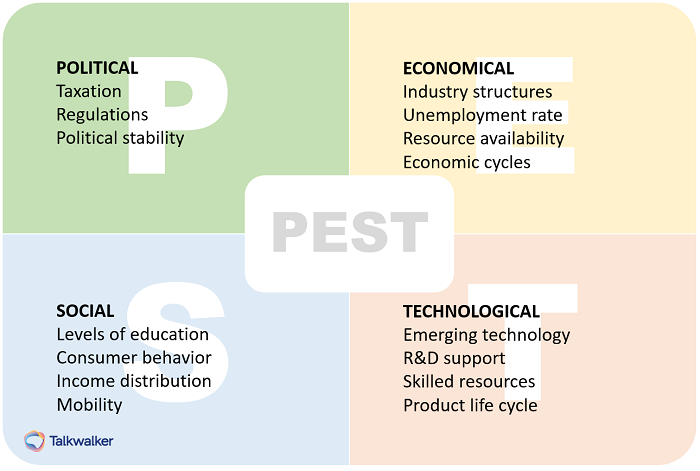
PEST analysis - Political, Economical, Social, Technological.
Competitive intelligence
This is a biggie, and if you’re so inclined, I’ve a competitive intelligence guide you can check out. It’s full of techniques, real-life examples, tools, and templates.
Where do you rank compared to your competitors? Why are they outranking you? How can you outsmart your competitors?
Competitive intelligence data feeds both your marketing strategy and your marketing plan. Understanding the competition will bring new ideas and fresh insights to inspire you and your team.
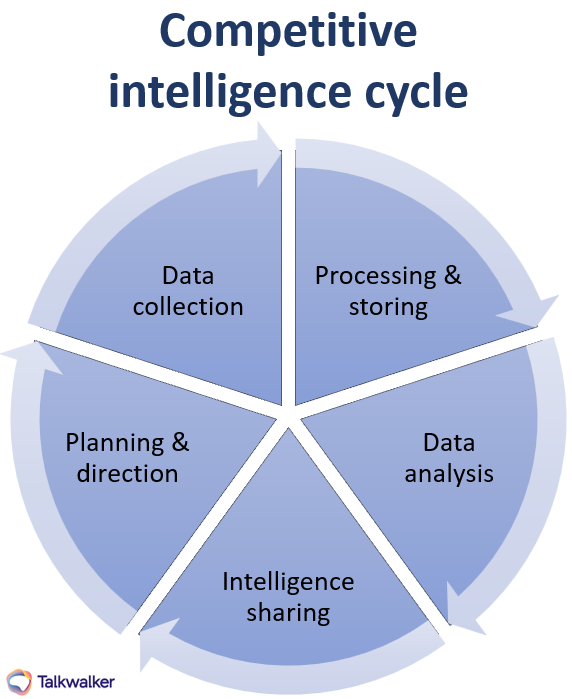
Marketing strategy - competitive intelligence cycle.
Information => intelligence => action
- Information is where you start - data about competitors, stats, company info, product intel, marketing strategies
- Intelligence is info that’s been analyzed, with insights squeezed out to enable decision making, such as whether to discontinue a product or which audience segment to target
Your brand doesn’t exist in a bubble. You must consider the broader competitive space. You must gather, analyze, and share intel about new products being launched, price cuts, new audiences, and emerging competitors. Insights into the competition will help your brand grow, protect your brand from extinction, and improve your marketing campaigns.
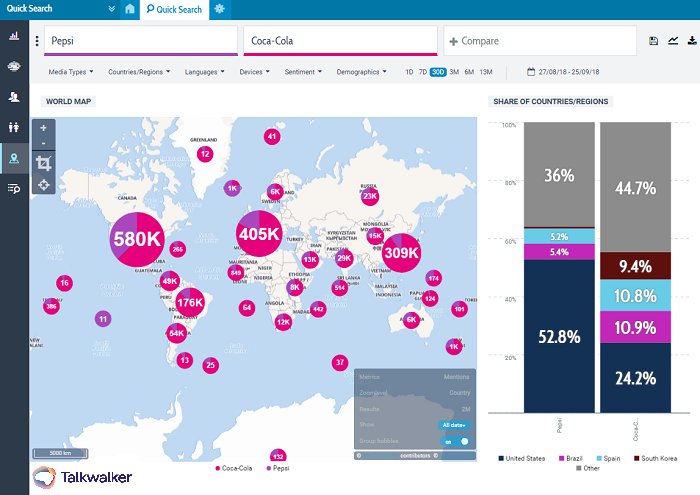
Quick Search competitive intelligence analysis.
Coca-Cola has a 9.4% market share in South Korea. CI identifies a country that Pepsi should target.
Here are three ways competitive intelligence will help your brand...
- Understanding the competition - analyze and put into perspective to feed your marketing campaigns for the future. You'll also discover how they’re performing and why customers choose them over other brands offering similar products. If you don’t understand your competitors, what they're doing, how will you compete and win?
- Identify best practices - are they creating marketing campaigns that are proving more successful than yours? Does their website bring more traffic, more sales? Are their email campaigns more punchy? Do they have more social media followers? Are they using more/different social networks that are proving popular?
Look and learn!
- Find strengths and weaknesses - how will their strengths threaten your company? How can you take advantage of their weaknesses and find new opportunities? I’m not suggesting you jump in their grave, but…
If you'd like to read more about competitive analysis, take a look at my guide - How to conduct a competitor analysis. It walks you through the what, why, and how - to identify opportunities for improving your business.
Review and update your ideal customer profile
Understand your target audience - how they communicate. Where they communicate. The demographics - gender, job title, location, interests, language, pain points. What they're spending their money on, etc. Getting to know your audience means you'll be able to write content that they're eager to engage with. Launch products that they're desperate to buy.
The goal is to attract new customers that are like the best ones you already have. Look at your existing customers and identify what makes them profitable, loyal, engaging, and fun to work with. Confirm that the ideal customer profile and marketing personas established last year, are still accurate.
Compare the results from last year with the results from this year. Did the data change? An increase in female customers? Different age bracket dominating? Depending on the results, you can target your marketing campaigns to take into consideration possible changes, ensuring you’re still targeting the correct audience. Take a look at all the demographic information you can pull out.

Audience demographics found by Talkwalker Quick Search.
Step 2 Idea generation
Let’s regroup.
- You’ve compared last year’s objectives and results - what worked and what didn’t
- Your SWOT, TOWS, and PEST analysis are done and you've been brutally honest - painful, but worthless if you aren’t
- Competitors have been checked out - hey, they’re checking you out too
- You’ve established that any changes to your customer demographic will be reflected in your new marketing strategy
Now let’s go crazy! Or, in industry terms, let’s start planning.
Brainstorm to find new perspectives and define problems
Last year's marketing plan worked like a dream.
But, what worked last year, isn’t necessarily going to work in the future. The pace of change is rapid, and you need to be able to adapt your plan if necessary.
Since you drew up last year's marketing plan, you’ve launched new products, your competitors have launched new products. There have been changes in your industry, your customer base has shifted, your competitors have announced new partnerships. Your marketing strategy needs updating before you can launch any new campaigns.
Okay. Updated. It's now a relevant, working business model. It's time to start using it to create your marketing plan campaigns.
Brainstorming is for problem solving, generating new ideas, encouraging cross-functional communication, identifying your competitive advantage, and for promoting innovation.
When you brainstorm as a team - white paper, blog post, webpage, video, event, product launch - it strengthens your team, cultivating a feeling of team ownership.
One industry that has changed dramatically over the last couple of years is financial services. While traditional banking is still a thing, digital banking has increased due to the lockdowns around the world. Marketing for financial services had to adapt quickly. This kind of flexibility is crucial for brands looking to meet new consumer demands and preferences.
Ignite the little grey cells
To generate new, creative ideas and solutions with interaction and group chat. So, who do you include in your brainstorms?
Invite all those who’ll be directly involved with managing and implementing your marketing campaigns. That could include content writers, market ops, community managers, graphic designers, demand generation, UX designers, email campaign officers, SEO and SEM specialists.
But, if you've launched new features, input from the product team would be helpful. If you're targeting a new country, sales intel would be great.
Preparation
There is no preparation, you start with a blank canvas; no researching, no preconceived ideas.
Think outside the box
Yeah, sorry, I hate that expression too. But this time, it works.
- Forget what you know
- Encourage crazy ideas
- Build on the ideas of other
- Criticism kills
- Get visual
- Quantity is good
Nothing destroys the energy in a brainstorm quicker than calling an idea stupid - it’s a real cheap way to prove your own superiority.
Talk to other teams for customer insights
Oh yes, like it or not, you're going to have to venture out of your office and talk to people.
I've already talked about including product and sales in brainstorms, but it shouldn't stop there. Take advantage of your customer-facing teams - sales, customer support, account managers. Each team has a unique perspective on customer touchpoints, behavior, spending power. Feedback from these teams gives a more comprehensive picture of your customers and your prospects, and how to keep them happy.
Tips for sharing information...
- Centralize customer insights - build a database/wiki/intranet to store survey results, market research, support calls, customer testimonials
- Ask customer-facing teams to share their findings with back office teams. A bug hunt for dev and new feature requests for product
- Mix up your teams - sit a project manager on an email marketer’s knee, get marketing to hold hands with support
- Listen to your team - encourage feedback from your employees across the board. Anonymous, if they’re a timid bunch
This is information that you should have already collected for your competitive intelligence program.
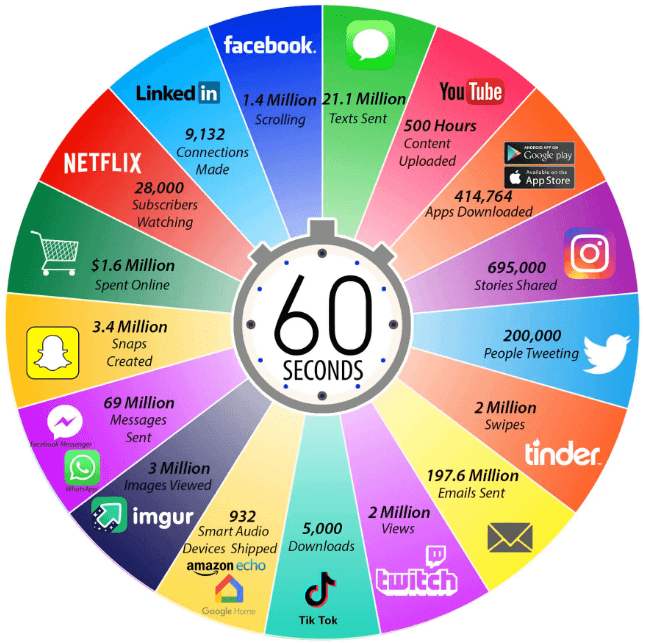
What do you see? A challenge or a nightmare?
(Created by @LoriLewis & @OfficiallyChadd)
Your vision statement - where do you see your team going?
This is the heart of your team. The big picture of your overall goals, where you see your team in the future.
Tips on writing your vision statement...
- Don’t be afraid to dream big
- Be clear and concise
- Let your passion and emotions run free
- Share your vision statement with your team
- You have to be prepared to put in the hours to achieve your vision
Here’re some great Examples of vision statements to spark Your imagination. Brands include IKEA and Nike.
Vision for your team
Keep it simple. Take a look at the image below, that’s all it needs to be.
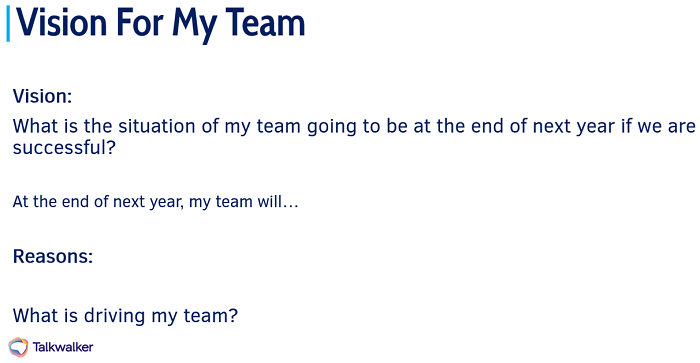
Your team's vision statement.
Your mission statement - where does your team exist?
A clear, concise declaration about your marketing strategy, the reason your team exists. Focus on what your team does for the company, and what it wants to achieve. Added bonus, it helps keep your team focused on your objectives. Answer these questions...
- What do we do?
- How do we do it?
- Who do we do it for?
- What value are we bringing?
Take a look at this blog post - What great brands do with mission statements. Eight big names and their mission statements, including Google, Amazon, and Virgin.
Marketing tools
Tactics, strategies, tools, and coffee.
We've published several blog posts that list the best martech tools on the market, along with a guide on why you need them and the analysis you can perform. The tools you’ll need, depend on the campaigns you plan to run. Here’re some suggestions...
- Twitter analytics tools
- Instagram analytics tools
- Social media monitoring tools
- Social media analytics tools
- Image recognition tools
- Social listening tools
- Competitor analysis tools
- Hashtag tracking tools
- Sentiment analysis tools
- Text analytics tools
- Video analytics tools
- PR tools
- Data visualization tools
Step 3 Strategy
You’ve moved on from crazy ideas, and now it’s time to formalize your marketing plan.
Your marketing plan
You’ve outlined your target markets and brought the four Ps into play - product, price, people, promotion.
More about the four Ps of marketing later in the post.
It’s not uncommon for digital marketers to be so reactive, that we run out of time to be proactive. But, it’s imperative that we find time to plan campaigns to enable us to achieve maximum profit and sustainability.
Internal strengths and weaknesses identified, external opportunities and threats recognized, you can now build a strategy that plays on your strengths, and minimizes your weaknesses.
Identify your assets
What assets do you currently have that you can use to make your campaigns work? These are strengths, so refer back to your SWOT analysis for inspiration.
Here’re some examples of assets you're probably already using...
- Website
- Blog
- Email subscribers
- Newsletter
- Social media channels
- eBooks and guides
- Corporate brochure, fliers, etc.
- Videos - sales and training
- Customer and influencer testimonials
- High page ranking in search engines
- Solid domain authority
- Influencers, brand ambassadors
- Trade shows, events, webinars
- YOUR TEAM
Do these assets need updating? Or could they be more effective if refreshed or relaunched. Here's a helpful website launch checklist.
Action plans
Action plans - what your team is going to do to achieve your goals. Each plan has to specify:
- What'll be done - e.g., email campaign run throughout the year to attract potential customers
- Timeline - start, review, finish
- Who’s responsible for what
- Cost - e.g., printing, event stands, new team members, travel - estimate based on past expenses
- Measurable projected outcome - e.g., 50 conversions, new partnerships or sponsors
Your team's priorities for next year
Use a template - shown below - to demonstrate how you'll achieve your vision. List your assets - refer to the last year's performance and your team's vision.
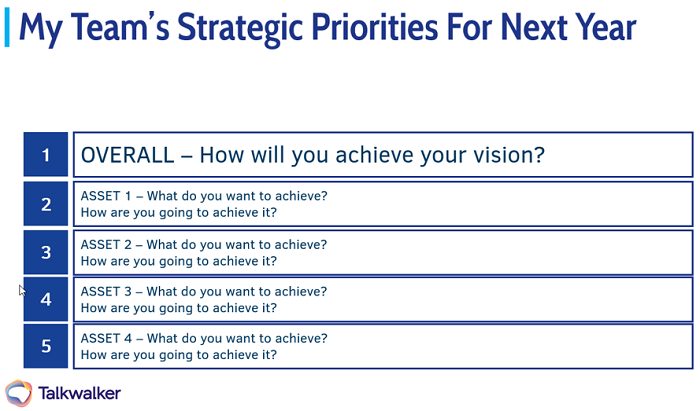
Demonstrate how you'll achieve your vision.
Step 4 Setting goals
Where we’re at.
You’ve had a cracking brainstorming session with your team, solved issues, generated exciting new ideas, and cultivated a warm, fuzzy feeling of team ownership.
You’ve bounced ideas off other customer-facing teams and found new insights.
Vision and Mission statements are completed, and you’ve checked out some interesting stats. Now it’s time to set your goals.

Your head may be bursting with exciting ideas, goals you want to achieve. But, you can’t pluck them out of thin air. The first step to planning effective and achievable goals is to define your strategic objectives. For this you need to be SMART.
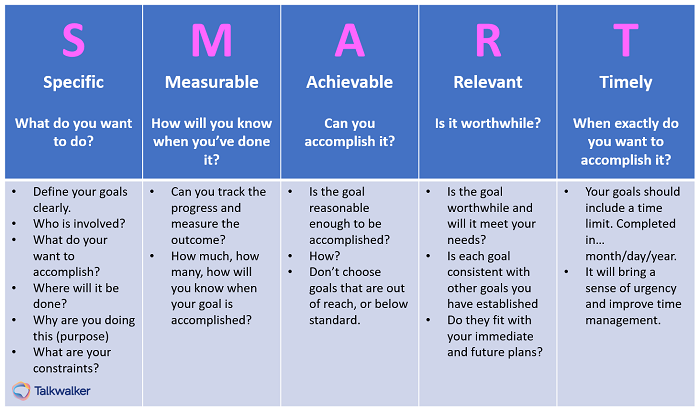
SMART - specific, measurable, achievable, relevant, timely.
- Specific - real numbers with real deadlines: who, what, where, why?
- Measurable - how will you track and evaluate your achievements?
- Achievable - work toward a goal that’s challenging, but possible.
- Relevant - do you have the resources to make it happen?
- Timed - when will you achieve your goal?
You team’s goals for next year
Use a template, - shown below - and list your strategic goals.
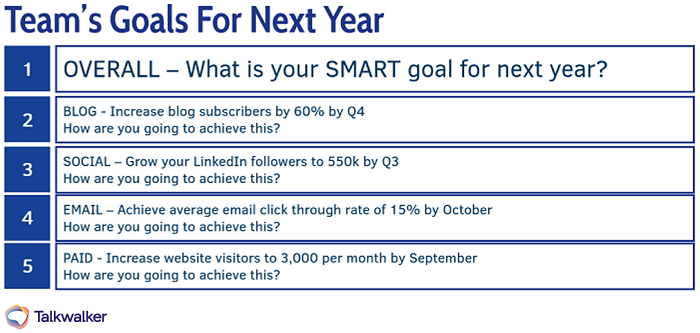
Determine your strategic goals for the following year.
The key to setting achievable marketing goals is to understand your current position. To move forward, you have to look backwards. Makes sense?
How many goals?
Your choice.
Some marketing plans concentrate on a single goal, while others have 1-2 core goals that impact the bottom line, and important initiatives or channels. I’d advise against more, as you’ll lose focus.
What type of goals?
Choose goals that you care about, that are authentic, that are achievable. The type depends on what stage your business is at. If you’re a newbie company, focus on engagement and listening to feedback to validate your products and your content. Later, focus on growth metrics.
Avoid these pitfalls:
- Assuming you know what your customers want - you must listen to them and hear them. This is where I plug Talkwalker's consumer intelligence platform. Seriously, you'll be able to find out exactly what consumers are talking about, thinking about, liking, hating, feeling, sharing - give it a go!
- Ignoring your competitors
- Competing on price alone
- Growing too quickly
- Relying on a small customer base - you have to grow
- Becoming complacent about your product - innovate, innovate, innovate
There’s no secret formula that I can share with you. But…
- Keep it simple stupid (KISS)
- Stay focused
- Be authentic
- Load yourself up with data and insights
- Ensure your short-term goals support your long-term goals
- Always, always keep your team in the loop
Yes, I called you stupid. Live with it!
Step 5 Planning next year
So, let's pull it all together.
You've analyzed last year's marketing strategy, checked the figures, and found the ROI. Strategy sorted, goals vs results proved. After an electrifying brainstorm, you've set SMART goals. Quantitative and qualitative analysis has revealed what worked and what didn't. Your SWOT is set in stone, and your competitors’ performance has been pulled apart.
Now it’s time to pull it all together and prepare your marketing plan for next year. Ensure you’ve allocated enough resources to achieve your goals - people and money. The size of your budget depends on how much you have to invest, and how quickly you want to see results.
Time to meet up with the board. Present your marketing plan, supported by your marketing strategy. Break it down month by month and demonstrate what your team is going to do and how you’re going to achieve it.
Good luck!
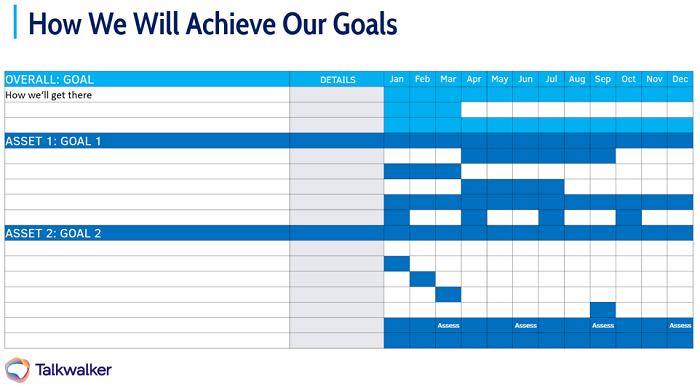
Planning next year - how will you achieve your goals?
Your marketing plan
Alrighty... time to write your marketing plan. Keep it handy, because you’ll be using it throughout all your planning, monitoring, and analysis of your campaigns. You must include…
Executive summary
A simple overview of your plan.
Target market
Pain points, buying behavior, goals, messaging.
KPIs
Key performance indicators - to measure the success of your campaigns, such as…
- Cost per lead
- Client value
- Sales revenue
- Website traffic to lead ratio
- Lead to client ratio
- Inbound marketing RIO
- Conversion rate of landing pages
- Volume of organic traffic
SWOT, TOWS, and PEST analysis
Goals, strengths and weaknesses, environmental impacts, market analysis, challenges.
4 Ps of marketing
- Product - your offering in the marketing place and how it’s different from your competitors. What do consumers think of your brand? How do they use it? Where do they use it? If they aren’t buying your product, who are they buying from and why?
- Price - your pricing model and how it differs from others in your market. Why do consumers choose your product over others?
- People - who are your customers? Who are the consumers you’re targeting? Consumer insights will help target your marketing campaigns, so you’re speaking to the right segment, in the right language, with the right tone of voice.
- Promotion - channels you’ll use to promote your brand - online ads, blog posts, email, events, social media. Concentrate on benefit-driven promotion to drive a superior value proposition.
Branding and website
Prove yourself to be a thought leader in your industry with content on your website that’ll help consumers and customers visiting your site. If your site is seen as a place where they can learn and benefit from your content, they’ll keep coming back. Ensure that your messaging resonates with your target consumer. That you’re talking their language. Establish trust, and you’ll generate more leads.
Content strategy
Evaluate your existing content strategy to ensure it’ll work in your marketing campaign. Update or repurpose your messaging to increase engagement with your audience.
Marketing channels
Establish which channels you’ll use to communicate with your target consumers. Which channels do they currently use? If you’re not on the same channels, you won’t be heard.
Social media marketing
Ensure you’re on the same channels as your audience. No point promoting on Twitter if your audience hangs out on Instagram. Will you work with social media influencers? Do you use social media as part of customer support? Do you reply to every comment - good or bad? How often do you post? How are you monitoring and measuring your social media strategy?
How to create a social media report will show you everything you need to monitor and analyze, and how to present your results.
Budget and resources
How much will you allocate to your marketing efforts - paid ads, events, digital, website? Will you need to invest in more martech tools? Does your team have the knowledge needed or will you need training? Establish who’ll be responsible for each part of your campaigns - content, social media, email, paid ads, design.
Presenting to your board
Time to meet up with the board. Present your marketing plan, supported by your marketing strategy. Break it down month by month and demonstrate what your team is going to do and how you’re going to achieve it.
Easily measure your marketing campaign effectiveness
Want to measure the success of your marketing strategy? Read on to discover our simple framework for campaign measurement, to prove the success of everything you do.
Enjoy!




